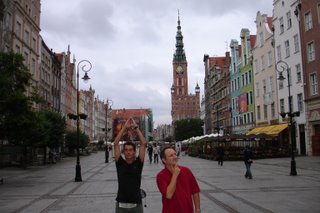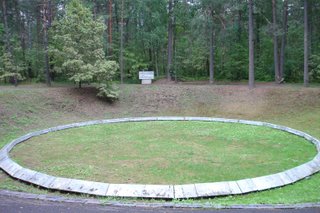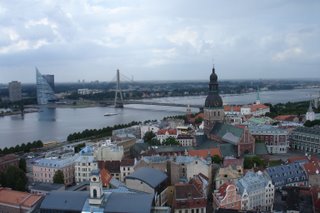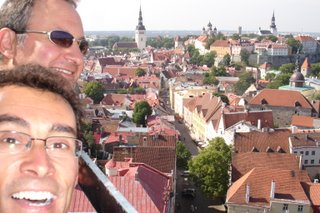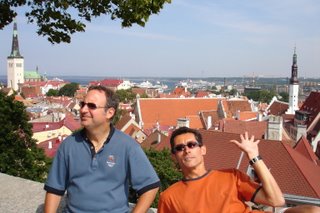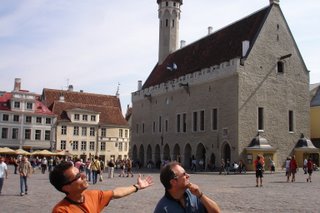

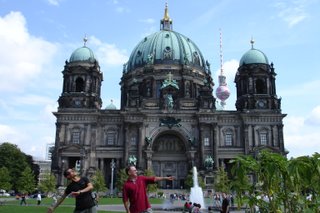
Berlin is big. It has 3.5 million people living in an area, almost six times the size of Paris! This is because it is spread out, has lots of park land and more houses rather than apartments. A very extensive above ground rail, below ground rail, tram and bus system makes it seem much much smaller. Germany's 83 million people are also more evenly spread throughout over its 356,866 square kilometers (two thirds France).
Since Paul and I were last here in 1995 and 1993, much has changed. Lots of new buildings and sites. We visited the huge 28 million euro, "concrete block maze" Holocaust museum, opened in May 2005, just down the road from the Brandenburg Gate and ironically, next to the site of Hitler's lost bunker! It summarises every single Nazi death camp and Jewish memorial in WWII in all of Europe. Also new is the Berlin Guggenhaim (very disappointing - only one exhibit at a time in a small building).
Other older sites, not visited last time include: Oranienburger Strasse (Jewish Quarter, fall of cafes), Maassen Strasse and Nollendorf Platz (the Oxford Street and Taylor Square of Berlin with flashy Indian and Thai restaurants) and Gendarmenmarkt Platz (plaza with classic concert hall and music museum).
Rebuilt or cleaned sites since last time include: Reistag (Parliament), Brandenberg Gate (first photo), Potsdamer Platz (CBD with fabulous new Sony Centre) and Alexander Platz (new apartments, cleaned red town hall).
Classics include Kurfurstendamm (ritzy shopping boulevard with old and new bell towers at its end - second photo) and the fabulous Berliner Dom (protestant Cathedral, third photo). Overall, the Berliners were: very friendly, happy to speak in English, love having long breakfasts (they are much bigger and are available all day) and still have coffee and cake in the arvo!

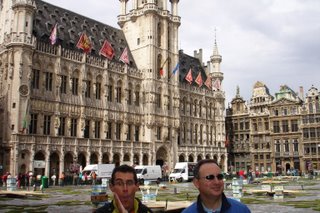
 Brussels (pop 992,000, founded 11th century) is a melting pot of cultures. Apart from the age old rivalry between the Dutch based Flemish and French based Walloons, we noticed many Africans (Belgian colony of Congo), Turkish and Lebanese. Belgium is one third the size of Greece (30,000 sq km) with the same population of 10.2 million. Brussels claims that it invented "pomme frites" to go with its mussels and has the best beer and chocolates in the world! It certainly has the grandest plaza we have seen in Europe (first two photos)! The Manneken Pis (third photo) now has a girlfriend! She is called "Jeanneken Pis" and yes, she is also releaving herself (European Union Laws would not allow us to broadcast photos)! Paul and I have been to Brussels before and new sites we saw on this occasion included: the only operating brewery in Brussels (this beer is made the traditional way - open air fermentation), the chocolate musuem (saw how pralines are made, PS: the Belgians have confirmed that white chocolate is not really chocolate but cocoa butter!), the 1857 "Neuhaus" chocolate shop (invented the praline or filled chocolate) and the Cathedral of Sts Michel & Gudule (where the old monarchs are buried and the official parish of the Belgian Royal Family). Total distance travelled so far: 19,058km.
Brussels (pop 992,000, founded 11th century) is a melting pot of cultures. Apart from the age old rivalry between the Dutch based Flemish and French based Walloons, we noticed many Africans (Belgian colony of Congo), Turkish and Lebanese. Belgium is one third the size of Greece (30,000 sq km) with the same population of 10.2 million. Brussels claims that it invented "pomme frites" to go with its mussels and has the best beer and chocolates in the world! It certainly has the grandest plaza we have seen in Europe (first two photos)! The Manneken Pis (third photo) now has a girlfriend! She is called "Jeanneken Pis" and yes, she is also releaving herself (European Union Laws would not allow us to broadcast photos)! Paul and I have been to Brussels before and new sites we saw on this occasion included: the only operating brewery in Brussels (this beer is made the traditional way - open air fermentation), the chocolate musuem (saw how pralines are made, PS: the Belgians have confirmed that white chocolate is not really chocolate but cocoa butter!), the 1857 "Neuhaus" chocolate shop (invented the praline or filled chocolate) and the Cathedral of Sts Michel & Gudule (where the old monarchs are buried and the official parish of the Belgian Royal Family). Total distance travelled so far: 19,058km.



